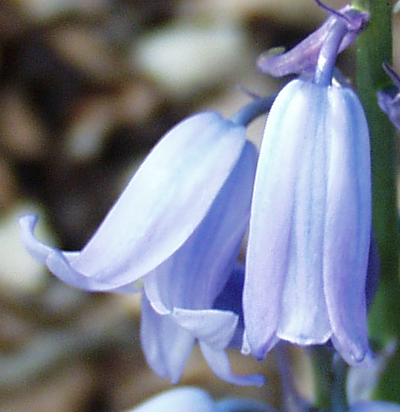Hyacinthoides, bluebells |

Inflorescence
of a pink cultivar of the
Hybrid bluebell

The flowers of bluebells are usually bell-shaped
Originally native to western Europe and North-West Africa, as ornamental plants cultivated worldwide, the bluebells contain only four species. They are herbaceous, perennial, bulbous plants with annual, egg-shaped bulbs. The plants form a few leaves which are basal, parallel-veined, sessile, entire, long and narrow.
The leafless stalk bears a loose raceme with many flowers. The axis of the inflorescence is called flower scape. The pedicels are surrounded by 2 linear-lanceolate bracts. The 6 identically looking tepals are blue, at cultivated varieties they can also be pink or white. At the base the petals are free or shortly fused and form star-shaped or bell-shaped, nodding or erect flowers.
Between the base and the top center of the tepals arise 6 incurvate stamens with thin filaments, whereas the 3 inner ones may be slightly shorter than the outer ones. The superior ovary consists of 3 fused carpels. It bears a stylus with a simple style with a capitate stigma.
After pollination by bees, bumblebees, moths or flies a dry fruit capsule is formed, that opens up with 3 valves and releases 3–30 spherical or broadly ovate, black seeds. Bluebells reproduce vegetative by forming daughter bulbs.
| Floral formula: |
| * [P(3+3) A3+3] G(3) superior
or * [P3+3 A3+3] G(3) superior |
The Hyacinthoides can be differ from genera such as Hyacinthus or Scilla by the presence of two bracts at the base of the peduncle, in similar genera they are missing or there is only one.
Meaning of the spesies name
- massartiana: named after the Belgian botanist Jean Massart (1865–1925)
Interesting notes
-
Hyacinthoides × massartiana, the hybrid bluebell, of which there are several varieties, is the most common feral bluebell. From garden centers it is wrongly sold under the name of Hyacinthoides hispanica or H. non-scripta.
-
Before their classification as Hyacinthoides the plants by various authors were listed under different genera such as Scilla, Usteria, Limonanthe, Endymion and other.